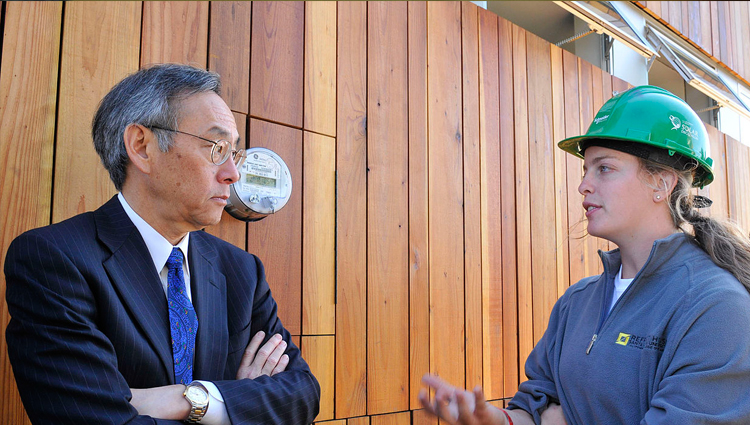Solar House Brings Kentucky Landscape to Nation's Capitol

(Inside Science) -- "If you're up close to it, it just looks like a texture," said Gregory Luhan, a professor from the University of Kentucky. "But if you stand far away from it, across the street, it looks like a landscape."
Luhan was talking about the outside of the solar house built by University of Kentucky in Lexington, which now stands on the National Mall in Washington along with 19 other homes powered entirely by the sun. Shipped in pieces from universities around the world, the structures are all competing in this year's Solar Decathlon, sponsored by the Department of Energy.
"We're creating art out of the intersection of handcraft and digital craft," said Luhan, who commissioned a UK graduate to take photographs of Kentucky landscapes that were used to create the artistic pattern the outside of the house that lights up at night.
For the past two weeks, this solar shanty town has attracted thousands of tourists, students, and politicians. They walk through the unusual neighborhood, lining up for tours and picking their favorites.
"About 2,000 people come through our house each day," said Thomas Rauch, team member for Pennsylvania State University's nearby Natural Fusion house.
The energy produced by these small structures, each limited to 800 square feet, powers all of the lighting, appliances, and air conditioning within. And on sunny days, when the houses produce more electricity than needed, they pump the extra energy directly into the regional electrical grid that powers Washington.
The event was kicked off on Thursday by Secretary of Energy Steven Chu, who described his experiences making his own home more efficient.
"I started doing this long before I knew about climate change. And I have to confess the only reason I was doing that is because I'm fundamentally cheap," Chu said.
Chu said that during his time at Lawrence Berkeley National Laboratory in California, he became convinced that houses could be made 75 or 80 percent more efficient in terms of energy usage -- before adding any solar panels. He also announced an additional $87 million in DOE funding to further the solar university research on display in the homes.
Many of the homes look like something out of a science fiction film. The German team, for example, built a gleaming black cube with solar panel walls that pumps out twice as much energy as it consumes.
Kentucky's team brought pieces of their home state with them. The interior walls of their house -- named "s.ky blue" -- are made of local cherry wood, the ceiling of white maple. And the chairs can be collapsed into straight boards that hang from pegs on the wall, a trick borrowed from Kentucky Shakers, who Luhan credits as experts in making the most out of an interior space.
Electronics hidden in the hand-crafted interior allow the entire house to be smart phone-enabled -- the interior lighting and temperature can be changed remotely with an iPhone application. Or the house can be set to adjust interior conditions automatically, using sensors that monitor time and weather data to tint electrochemical windows and dim light levels.
"If it senses a cold front is moving in or a storm front is moving in, the home basically starts to prepare for that climatic change," Luhan said.
The house is also built with smart windows, which can tilt slightly off their frames to create a cross-breeze and tint to bluish color when an electric current is switched on.
"It's for efficiency, and it also just looks cool," said undergraduate Ricky Williams. "It gets the ooh's and aah's."
Kentucky's house is estimated to cost $300,000 to build commercially, less than the average cost of a home on this block -- $490,000. The cheapest residence -- the Texan "Zerow" House, intended for lower-income inner-city neighborhoods -- is built with walls of galvanized metal and could retail for $140,000. , On the other hand, the customized electronics and solar panels in Ontario's North House contribute to a cost upwards of $800,000, a sum targeted at young urban professionals.
But the point of the contest isn't just to showcase new technology. Each team is scored in ten different categories that include engineering, lighting design, and architecture, but also market viability, comfort, and communications. Though the students don't actually live in their houses (D.C. law prevents this), their houses must provide everything needed for daily living. Several times a day, they pump out 15 gallons of hot water that could be used for showering. The teams also run a suite of appliances that include dishwashers, clothes washers, refrigerators and televisions.
Teams that score well overall are those that focus not only on the individual pieces of the house, but on how the pieces fit together to create a the houses focus on a systems approach -- designing a house not piece by piece, but as a giant system.
"As we went through the 70s and the 80s, we had terribly unreliable systems that gave solar a black eye," said Richard King, director of the Solar Decathlon. "As we move into the future, to do it right we have to start from the ground up and make the whole house a system, so it's all integrated."
The UK team is currently in 12th place. When the contest ends on Sunday they will begin to pack up their building for the trip home. Once back in Kentucky, it will be used as the visitor center for the 2010 FEI World Equestrian Games in Lexington, Luhan said.

